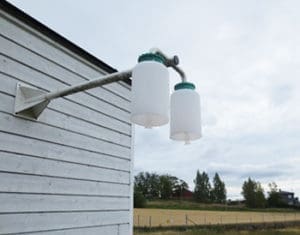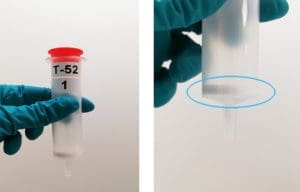The environmental contaminants known as siloxanes are in your shampoo, your lotions and your deodorant. Siloxanes are odourless, invisible, and they can be toxic to aquatic animals. They are also heavily restricted in wash-off hygiene products, and further regulations are under consideration. But, how can we know that the regulations work?
Siloxanes are silicone-based compounds used in deodorants, shampoos, skin creams and hair styling products. These are the substances that make such products smooth and easy to apply.
They can also be toxic. Research shows that some siloxanes may have environmentally hazardous properties. They break down slowly in the environment and can accumulate in living organisms. A main concern is the discharge of siloxanes from wastewater, as siloxanes can accumulate in aquatic organisms such as fish.
Siloxanes travel by air to the Arctic

Siloxanes are emitted mainly to air and can be transported far away by air currents. Thus, scientists find them in air samples taken as far away as Svalbard in the Arctic.
Scientists at NILU – Norwegian Institute for Air Research, have monitored siloxanes as part of an ongoing programme at NILU since 2013, on behalf of the Norwegian Environment Agency. Part of the work is to continuously improve air monitoring methodology to ensure that the data provided is as accurate as possible.
As of 1 February 2020, industries within the European Union were no longer allowed to use more than 0.1% of siloxanes D4 and D5 in daily care products that can be washed off during normal use. (Commission Regulation (EU) 2018/35).
“To be able to document changes and assess the impact of newly imposed regulations, we need continued and precise atmospheric monitoring of siloxanes”, says senior scientist Nicholas Warner at NILU’s department for environmental chemistry in the Fram Centre, Tromsø.
Remote air sampling requires stability
Remote atmospheric sampling is done by placing different kinds of air samplers at faraway locations, where the chance of local air pollution is low. The Zeppelin Observatory outside Ny-Ålesund on Svalbard is one such remote location. In a new study, Warner and his colleagues placed what they call “active air samplers” there, to trap airborne siloxanes transported to the Arctic by air currents coming from more polluted areas.
Active air samplers are connected to a pump, which draws air through the samplers over time. In the samplers are containers packed with materials knows as sorbents. The sorbent material is what traps the siloxanes and other airborne chemicals from the air.
Using active air samplers makes it possible for the scientists to know exactly how much of a given chemical is present in the volume of air sampled. When air sampling is done, the containers containing sorbent material are sent to the laboratory for extraction and analysis.
“When doing remote sampling, you’re often not able to collect and analyse the samples right away. The samples are often stored for time periods ranging from days to weeks before they are sent back to the lab for analysis”, Warner explains. “Thus, you need a material that your samples remain stable on.”
Aims to eliminate uncertainties

In a recently published article in the scientific journal Chemosphere, Warner and his colleagues present their work on improving the data quality from remote atmospheric monitoring of siloxanes.
They did this by aiming to eliminate any uncertainties associated with the monitoring, in this case by comparing and evaluating two different air sampling sorbent materials.
For years, NILU and others have used the sorbent material Isolute ENV+, even though it is known that the material’s chemical structure causes the siloxanes to break down. Warner and his colleagues believe that the ENV+ structure creates an acidic environment, especially when moisture is involved, causing the siloxanes to degrade.
“What happens is that the siloxane known as D5 will break down into D4, thus skewing the measurement result”, says Warner. “This is well known, and we use correction curves to correct for it. Still, there is some variability and uncertainty associated with the correction, so we needed to explore other options.”
The alternative option they chose to evaluate was the sorbent material Isolute ABN Express.
According to Warner and his colleagues, the ABN material provides a more stable environment during sampling and storage with no signs of breakdown occurring. This in turn provides greater accuracy for the atmospheric monitoring of siloxanes.
A more stable sorbent means they can now report reliable data for D4, according to Warner. With the old sorbent (i.e., ENV+), D4 results were derived directly from the air sampling, but also as a result of D5 degrading further on the material. Thus, earlier reports on D4 concentration were considered qualitative at best.
Additional atmospheric degradation mechanisms?
In a study published last year, Warner and colleagues used global measurements to evaluate the siloxanes’ potential to travel long-distance through the air, and for how long they can stay in the environment (persistence). They discovered that the distribution of siloxanes in time and space (spatial distribution) described by measurements contradicted models used to predict chemicals’ behaviour in the environment.
This difference could be attributed to additional degradation mechanisms facilitated by atmospheric particles, which is not accounted for in model predictions. Previous laboratory experiments have shown siloxanes to breakdown when they attach to particles in the atmosphere.
However, data used from several sampling studies was collected on the unstable ENV+ sorbent, limiting the accuracy of their data analysis. This was one of the main reasons Warner and his colleagues wanted a develop a method using a more stable sorbent.
“We needed to find out why the model did not agree with what we were finding in the environment. Thus, we had to make sure that we ruled out any issues with the sampler. Now we’re confident that we’ve done that”, Warner says.
Switching from the ENV+ to the ABN sorbent did the trick – almost. Now, the atmospheric behaviour based on sampling measurements at the Zeppelin observatory in Ny-Ålesund, Svalbard agreed well with model estimates during the winter. In summertime, not at all.
“We had to ask ourselves, why would our results agree with model predictions in the winter and not the summer? Is siloxane breakdown by particles still occurring?”.
The effect of sunlight
Particle-related breakdown could well be the answer. It has been well documented that siloxanes break down in the atmosphere by reacting with hydroxyl radicals formed in the atmosphere by sunlight. Thus, siloxane concentrations begin to decrease when the sunlight returns to the Arctic.
Although the models account for this mechanism, agreement with measurements was only seen during winter. However, atmospheric aerosol/particle formation and accumulation occurs during the spring (March – May) and extends through to the Polar Summer (June – August). Whereas during the winter, particle concentration/accumulation is lower. Higher concentration of particles during the spring/summer may provide additional mechanisms in which atmospheric breakdown of siloxanes can occur during this time period.
“Thus, particle formation may still contribute to atmospheric degradation of siloxanes in the Arctic, but only during the spring/summer season”, explains Warner. “Now we are agreeing with the model, at least for wintertime. We also have a good hypothesis as to what happens in summer, which again could help us improve the model.”
Further restrictions ahead?
As of now, the existing restrictions on siloxane use are under evaluation. It is considered to extend them to include also the siloxane type called D6, and limit siloxane use in all professional and consumer products.
“Improving the sampling methodology has helped us gain better insight into the environmental fate processes of siloxanes in the Arctic atmosphere. Our improved understanding will in turn provide authorities with data needed to assess the changes in environmental concentrations of siloxanes, and hopefully be of use when deciding further restrictions”, Warner concludes.


